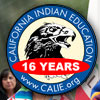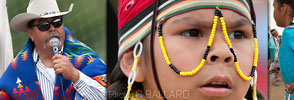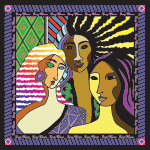 |
 |
 |
| ABOUT CALIE MISSION STATEMENT Publishing Corner: Indian Community: Science & Wonder Indian Heros: California Indian Art: CALIE Library: Academic Financial Aid: Tribal Governments: Indian Gaming: |

We all love and respect our Indian Womenby Roy Cook, Opata-Oodham, Mazopiye Wishasha: Writer, Singer, Speaker The 10th annual National Women's Health Week will kick off on Mother's Day, May 10, 2009 and will be celebrated until May 16, 2009. National Women's Checkup Day will be Monday, May 11, 2009. The eight-week Women and Girls Out Moving Across the Nation (WOMAN) Challenge, an online physical activity program, runs from May 10–July 4, 2009. National Women's Health Week is a weeklong health observance coordinated by the U.S. Department of Health and Human Services' Office on Women's Health (OWH). National Women's Health Week empowers women to make their health a top priority. With the theme "It's Your Time," the nationwide initiative encourages women to take simple steps for a longer, healthier, and happier life. During National Women's Health Week, communities, businesses, government, health organizations, and other groups work together to educate women about steps they can take to improve their physical and mental health and lower their risks of certain diseases. Important steps include: Getting at least 2.5 hours of moderate physical activity, 1 hour and 15 minutes of vigorous physical activity, or a combination of both each week.
Warrior Woman Dahteste Dahteste is described as a very beautiful woman who took great pride in her appearance and, even though she married and had children, she chose the life of the warrior. No one challenged Dahteste lightly for it was widely known that she could out-ride, out-shoot, out-hunt, out-run, and out-fight her peers, male and female, and she did so with grace. She was credited as being courageous, daring and skillful, and she took part in battles and raiding parties alongside her husband, and a good friend of her family, Geronimo. Fluent in English, Dahteste became a trusted scout, messenger and mediator between her people and the U.S. Cavalry. Along with another woman Apache warrior named Lozen, Dahteste was instrumental in the final surrender of Geronimo to the U.S. Government and, as thanks for her efforts in their behalf, she was imprisoned with Geronimo and shipped to prison with his remaining followers. Dahteste was as strong in her personal spirit as her warrior spirit, and she survived both tuberculosis and pneumonia while imprisoned. Both diseases killed untold thousands of Natives across the land, but not Dahteste. After 8 years in the Florida prison, Dahteste was shipped to the military prison at Ft. Sill, Oklahoma. After 19 years at Ft. Sill, she was finally given permission to return to her homeland. She lived the balance of her life on the Mescalero Apache Reservation until she died there of old age. Warrior Woman Lozen Lozen was the sister of mighty Apache war leader Victorio, and the most famous of the Apache War Women. Lozen was born in a section of New Mexico/Arizona/Northern Mexico known at that time as Apacheria, somewhere in the late 1840s. She let it be known at a very early age that she had no interest in learning the women's duties of the tribe, and set out on the warrior's path - taught by her famous brother. Lozen was quite unlike her counterpart, Dahteste. Lozen had no concern for her appearance and, even though she is in several famous photos of Geronimo with his warriors, there is nothing to indicate that she is a woman. You would never spot her. She was very manly in her appearance, dressed like a man, lived and fought like a man. She never married, and devoted her life to the service of her people. Victorio is quoted as saying, "Lozen is my right hand . . . strong as a man, braver than most, and cunning in strategy, Lozen is a shield to her people." Legend has it that Lozen was able to use her powers in battle to learn the movements of the enemy and that she helped each band that she accompanied to successfully avoid capture. After Victorio's death, Lozen continued to ride with Chief Nana, and eventually joined forces with Geronimo's band, eluding capture until she finally surrendered with this last group of free Apaches in 1886. She died of tuberculosis at the Mount Vernon Barracks in Mobile, Alabama at the approximate age of 50. ALBUQUERQUE, N.M.-Soldiers say they serve in the armed forces for freedom, for their families, for their country or for themselves. For three Native American women, their reasons were so much more. Barbara Pickering, Helena Anthony and her younger sister, Angela Barney-Nez, all served in the military. One was in the Vietnam War. Another woman, Mary Cohoe, served in the American Red Cross in the conflict there. "Women have come a long way," said Pickering, a U.S. Marine Corps veteran. "We've been there, done that and so forth." The Navajo women "were given a responsibility to represent our people," Cohoe added. The four women are featured in a new documentary film, "Navajo Women Warriors: Sani Dez-Bah," about Navajo women who saw service. A screening of the documentary took place last week at the University of New Mexico as part of the University Libraries Indigenous Nations Library Program. In interviews after the screening, the four women shared memories and thoughts on their time in the military. "There was a conflict between modern and cultural beliefs," said Anthony, a veteran of the U.S. Marine Corps and of the Vietnam War. "We were told to listen to our elders, and they usually said women shouldn't be in the military." Marine Corps Pickering said she didn't prefer one branch of the military to another when she decided to enlist. On her way to the Army recruiting office, she encountered a Marine recruiter, who told her about the Marine Corps. She said she signed up right away. "Little did I know my father had great respect for the Marine Corps," said Pickering, who served from 1970 to 1973. Anthony, another Marine, also " had a lot of support" from her family. She called her father "probably the greatest women's liberationist." Barney-Nez, who served in the U.S. Army, said she was determined to join the military to follow in the footsteps of her sister, Anthony, but "when I told her I was going to join, she said no. She said I was just a big crybaby and I can't handle it." Cohoe served in Vietnam as an American Red Cross "Donut Dolly." "We were the moral boosters," Cohoe said. "I supported the American G.I." Cohoe said she remembers telling her father she was leaving for Vietnam. "I told him, 'I'm going to Vietnam to be with brother to take care of him,' " Cohoe said. As a Donut Dolly, she said, she had the highest security clearance that enabled her to enter the battlefields and camps where soldiers spent their time. "I thought there were thousands of us (Donut Dollies) serving, but I found out there were only 700 of us in all different branches," Cohoe said. War Veteran She said she didn't consider herself a war veteran until other women veterans started recognizing her as such. "The Navajo women themselves were the ones who embraced me," Cohoe said. "They made me feel important." Anthony said she remembers being part of the second cycle of women in the Marines to train with men. "Before women were allowed to train with men, men and women had separate boot camps," said Anthony. "It was very hard." Anthony said her time in the military often reminded her of home, especially when she was in a bunker. She said it reminded her of a Navajo hogan, which is made of earth. Alice Carron, the documentary's director, said the film will be screened at the National Museum of the American Indian in Washington, D.C., within the next couple of months. Cohoe said the documentary brought back memories that some veterans don't want to think about, which is why some of them haven't attended panels or screenings even if they are featured in the film. "We wanted to share this with one generation to the next," Barney-Nez said. Sunnie Redhouse, Navajo, attends the University of New Mexico in Albuquerque. She is a graduate of the Freedom Forum's American Indian Journalism Institute. As with the 1990 Desert Storm, the controversy continues over where in theaters of operations women should serve and if they should be exposed to the threat of combat and capture. While in today’s warfare the traditional battlefield lines are blurred and all military personnel are susceptible to direct enemy danger, Native American history is replete with stories of women, like PFC Piestewa, who, by necessity or choice, found themselves in the midst of battle. One of the earliest is the account of Tyonajanegen, an Oneida woman who fought on the side of the United States at the Battle of Oriskany, in New York, in 1777. A bloody, six hour enemy engagement, Tyonajanegen, on horseback, fought by her husband’s side. When her husband became wounded in the wrist she continued to reload his gun so he might continue to fight. Tyonajanegen, also armed with a pistol, used her weapon against the enemy. In her book, Life amomg the Piutes, Sarah Winnemucca, describes how the women of her tribe took part in war, giving, as an example, her sister-in-law. “One splendid woman that my brother Lee married after his first wife died, went out into the battle-field after her uncle was killed, and went into the front ranks and cheered the men on. Her uncle’s horse was dressed in a splendid robe made of eagles’ feathers and she snatched it off and swung it in the face of the enemy, … and she staid and took her uncle’s place, as brave as any of the men.” Thank you all: Women Warriors, War Mothers, Aunties and carriers of our future with your power of creation. Back to Roy Cook's Articles page.
|
CALIF INDIAN EDU NETWORK: AHMIUM.org | SCAIR.org | SDICENTER.org | APAPAS.com
—
WEB SITE DESIGN
www.calie.org COPYRIGHT 2008-Present • ALL RIGHTS RESERVED